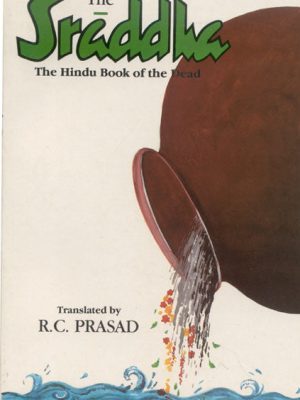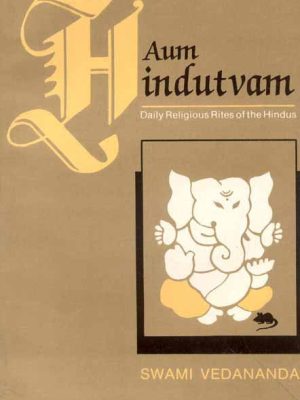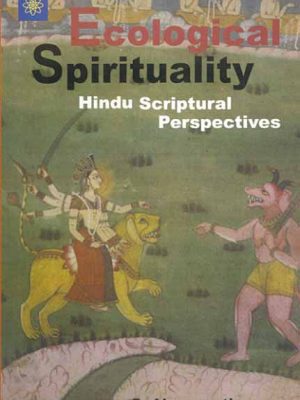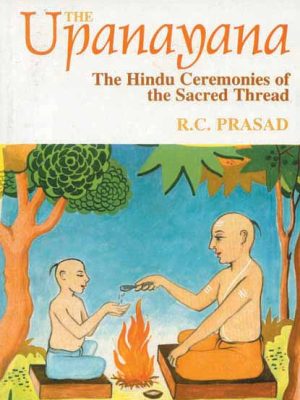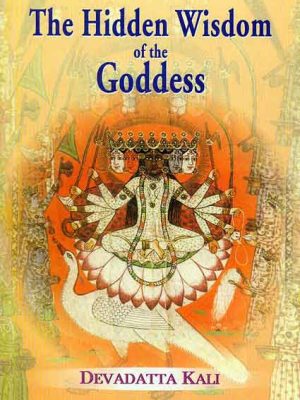Hinduism
-
The Sraddha: The Hindu Book of the Dead (A Treatise on the Sraddha Ceremonies)
The Sraddha: The Hindu Book of the Dead (A Treatise on the Sraddha Ceremonies)
Of the sixteen samskaras which encompass a Hindu life the last one is performed for the dead by their sons or grandsons or relatives. Many passages in the Puranas and Dharmasastras extol the role of the son in the life of devout Hindu. The present book deals with the rite of Sraddha and vindicates the popular belief that Sraddha, being an important topic, forms an integral part of Hindu Dharmasastra. The belief in the after-death survival of deceased ancestors and their separate world belongs to the Indo-Iranian period and as such is pre-Vedic. Ancestor-worship for one’s prosperity, continuation of one’s race, is as old as the Rgveda. Preface, Introduction, The Antyesti Samskara, Appendices, Glossary.
₹195.00 -
-
Aum Hindutvam: Daily Religious Rites of the Hindus
Aum Hindutvam: Daily Religious Rites of the Hindus
The author negates some of the very old concepts, viz., that females and
Shudras, and people who have not undergone the Upanayana Samskaras have no
access to Vedas or they should not perform Vedic rituals. He insists that
‘all religious observances of a man, if devoid of right conduct, are of no
avail. Right conduct constitutes an important element of education and
civilization. In his opinion Hindus will have to develop the
all-comprehensive idea of Hindu Dharma in and through their lives and
activities. Their welfare lies in the Vedic prayers and practices.
Those who are interested in Hindu Dharma, and those who want to know about
its rituals will find the present work indispensable. The author deals with
the religious practices, observances and rituals. When, how, and where
certain rituals are to be performed, is clearly discussed. Benefits of
Divine Communion are given special emphasis.
About the Author(s)
SWAMI VEDANANDA
₹195.00 -
Ecological Spirituality: Hindu Scriptural Perspectives
Ecological Spirituality: Hindu Scriptural Perspectives
Every major step man takes wreaks its own damage on the environment. Aware of this, man is yet unwilling to forgo the immediate material benefits his actions give. for all his professions of concern aabout the environment, in reality his concern reduces to nothing more than cosmetic changes in the exterior which are of no value. This celender monograph is critique on this pervasive culture of ambivalence. The author resorts to the first principles, Sanatana Dharmawhich literally means eternal order. Not environmental engineering but ecological spirituality is the answer. In Fact this is the only religion the world needs.
About the Author(s)
G. Naganathan
₹200.00 -
Arya Samaj Movement in South Africa
Arya Samaj Movement in South Africa
Even though it is primarily a religious organisation, the Arya Samaj movement emerged as a significant player in India’s fight for social and cultural autonomy, which involved both religious and secular groups. It was established in 1875, foreshadowing the establishment of an independent India in 1947. This work makes no attempt to provide a detailed
investigation of the movement, but also presents a summary of its development and philosophy in the context of the contributions made by its founder, Swami Dayanand Sarasvati. There is a lot of reason to be proud of the Samaj’s complex of institutions and upliftment programmes that they started, as well as the major historical forces that played a role in shaping the movement.
The nineteenth century saw the beginning of a number of different socio-religious groups, one of which was the Arya Samaj. Despite this, it was responsible for the construction of many of the most prestigious educational institutions in northern India. Indian groups who had immigrated to other countries, such as Mauritius, South Africa, and Guyana, were among the first to feel the impact of these events. What was once a little religious group has now grown into a religious denomination that has significant weight in the world today. One of the Arya Pratinidhi Sabhas may be found in South Africa.
the most well-known Hindu organisations that have a significant amount of sway over the north Indian subset of the Hindu people.
Author
T. Naidoo
About the Author
Originally from Johannesburg, South Africa, Dr. Thillayvel Naidoo went to school and graduated as a teacher. A graduate of the University of South Africa, he moved to India to pursue his M.A. in Indian Philosophy at the University of Madras. Research Officer at the University of Durban-Department Westville’s of Science of Religion. He is presently a professor of Philosophy of Religion at the university where he earned his doctorate. On Hinduism, he is the author of many publications on the subject: The Hindu Way, Sai Baba: An Analysis of Manifestations, The Parsee Community in South Africa, and Tamil People in South Africa.
₹200.00 -
The World Peace Agenda: Based on Shanti-Parva of the Mahabharata
The World Peace Agenda: Based on Shanti-Parva of the Mahabharata
This book presents Shanti-Parva’s peace-messages for consideration by everyone else. With the hope that plenty of purposeful discussion (with an open mind) will be held, to arrive at new proposals which can help bring world peace within the reach of humankind in the twenty-first century. Readers will discover that the peace-promoting messages of Shanti-Parva (when suitably interpreted) have universal appeal even today. These messages envisage the launching of a new peace-initiative, based on the explicit declaration of the Mahabharata verse 12.94.1 that says “wars cannot provide a satisfactory solution to any dispute”, and incorporate several novel features which are summarized in the last chapter of this book.
₹225.00 -
Kailash Mansarovar: Diary of a Pilgrim
Kailash Mansarovar: Diary of a Pilgrim
This profusely illustrated travelogue is a tale about fancies and fears, adventures and aspirations, expectations and disillusions, escapes and retreats experienced by a team of adventurous pilgrims. This is a story of an unforgettable odyssey to the holy Mount Kailash and the sacred Mansarovar describing mysteries connected with the land capturing the intangible air of faith and pilgrimage. This travelogue takes us on a journey to the wild, seldom travelled northern route visiting the remote cities, towns and monsteries of mysterious Tibet. It is a gripping story of pilgrims who aspire to see Gods living in the wilderness of the remote holy land. This is an engrossing, touching and remarkable account of a picturesque travel with nice imagery describing majestic mountains, turquoise lakes and virgin rivers of Tibet. Written in a brilliant style, it is a dramatic record that succeeds in imparting onto the readers some of the intensely experienced emotions that will remain long in memory. This book has been included in the Tibetan Travel Classics, Pilgrims Publishing, Varanasi, India and Pilgrims Book House, Kathmandu, Nepal.
₹225.00 -
Apad-Dharma in the Mahabharata: How to Face Calamities at Personal, State, and Global Levels
Apad-Dharma in the Mahabharata: How to Face Calamities at Personal, State, and Global Levels
The literal meaning of the Sanskrit word “Apaddharma” is “dharma appropriate at the time of calamity”. The Mahabharata’s use of this expression implies that, in the opinion of the author of this epic, the traditional varnashramadharma would not prove to be strong enough to protect the society, if and when there is a calamity. Therefore, Vedic scholars ought to have welcomed the messages of Apad-dharma when the society was actually attacked by external forces during the premodern period.
The historical background of the present study poses an important, academic question: “How could the Indian society have protected itself against external attacks during the pre-modern period?” Research-based answers to such Indiarelated questions occupy the initial part of this book to which a global dimension has been added by digging deep into Mahabharata’s innumerable stories. Results of innovative investiga-tions into the general question “How to face calamities at personal, state and global levels”, are presented here in terms of a modern, scientific framework, and expressed in a non-denominational
terminology, relevant to the problems of the 21st century. Readers from all parts of the world can get a strong message of social responsibility from this book, and accordingly make their contribution to the cause of world peace.
₹225.00 -
Hindu Prayers and Meditations
Hindu Prayers and Meditations
Hindus must pray daily morning at sunrise and evening at sunset one must have divine communication with God, and ask Him for Light and Guidance in life. Hindu scriptures abound in prayers. They are of different types and of complex nature, and form part of various rituals and ceremonies. In our daily life, however, we need not be bothered with these complexities. A few simple prayers, will serve our needs beautifully. The only thing we have to constantly keep in mind is the purity of our hearts and sincerity of purpose. We cannot offer prayers precariously and half-heartedly.
Author
D.N. Vidyarthi
₹225.00Hindu Prayers and Meditations
₹225.00 -
Rigveda-Bhashya-Bhumika: Hindi Anuvad Sahit
Rigveda-Bhashya-Bhumika: Hindi Anuvad Sahit
Rigveda-Bhashya-Bhumika: Hindi Anuvad Sahit
Author
Ramavadh Pandey
₹225.00 -
A Vedic Life: The Practical Philosophy of Nature
A Vedic Life: The Practical Philosophy of Nature
In Sanskrit, the word veda refers to knowledge, and the ancient tradition known as the Vedic tradition is linked with India and focuses primarily on knowledge. It is not about any one kind of information, but rather about knowledge in general as a tool for comprehending and experiencing reality. As a result, it is a tradition that does not restrict itself to one one system. Instead, it takes a perspective that is open and inclusive, and it believes that a reasonable approach is very necessary. However, it does not restrict itself to logic alone; rather, it also examines an approach that is focused on inner perception, since this is a vital aspect of both our knowledge and our experience of reality. The book titled “A Vedic Life” is a presentation that outlines some of the most significant aspects of the Vedic method of approaching information. It does this not for any specific religious or sectarian motive, but rather for the sake of knowledge, as indicated above, and as a result, it is anticipated that it will be able to contribute something to a range of opinions. Although the Vedas (books of wisdom) are intimately connected with the Vedic approach to knowledge because they exemplify its open and inclusive approach to information, the Vedic approach to knowledge is not limited to any one individual or book, as was previously noted. This aspect of the Vedic writings is expressed in a phrase from the Rig Veda, one of the core Vedic books, which states that “reality is one, but the knowledgeable call it by numerous names.”
The Vedic tradition is not the only one that has an open attitude toward knowledge; nonetheless, it is perhaps the most in-depth and oldest system of its kind. It is also the best maintained, despite the fact that a significant amount of its knowledge has been lost in modern times. Despite the fact that many of its pioneering philosophers had a completely different perspective, the system of contemporary science obviously clearly strives to the same ends; nevertheless, it does not truly recognise any other kind of thought than that which is founded on reason and sensory evidence. This book will examine the benefits and drawbacks of the methodology that is being used by contemporary science, particularly in light of the Vedic methodology for doing scientific research.
Because Sanskrit being the primary language used throughout the Vedic period, the book makes extensive use of Sanskrit words and phrases throughout its content. Once again, this is not due to any kind of ceremonial purpose; rather, it is due to the fact that the Sanskrit language used in the Vedas has a very well developed vocabulary in relation to psychology and philosophy. In addition, an effort will be made to show that Sanskrit is a natural language for the purpose of acquiring information, and this effort will be documented.
₹225.00 -
Mantra
Mantra
The encounter with the holy in India is a synthesis of three distinct aspects: performance, music, and visual presentation. One of three works that make up a trilogy that also includes Diana Eck’s Darsan: An introduction to the use of sound, or mantra, in the practise of Indian religion, Seeing the Divine in India gives an overview of this aspect of Indian spirituality. The use of mantra, which may take the form of prayers, rituals, and chants, is ingrained in the everyday practise of Indian religion, whether it is carried out at a temple or at home. This book explores the ability of mantra to bring about a shift in one’s state of awareness. It incorporates allusions to Buddhist, Hindu, Sikh, and Muslim as well as Sufi and Sufi traditions as it investigates the use and theory of mantra throughout a number of different religious systems, such as the Patanjali sutras and tantra. This updated version includes additional chapters on the use of holy sound among groups of Hindus and Sikhs who have migrated to North America, as well as on the practise of yoga and mantra in North America by people who are not of Indian descent.
₹245.00Mantra
₹245.00 -
Stories from Inscriptions : Hindu inscriptions
Hindu inscriptions are actually Government records. Therefore, they provide us authentic and detailed information about historical events and people that they record. A single inscription often contains valuable information related to events occurring in different periods. In fact, some inscriptions are so profound that merit a serious study for its own sake.
Hindu inscriptions also exhibit a powerful element of civilisational and cultural
continuity and reveal the fundamental unity of India cutting across kingdoms and geographies within this sacred land.However, it is astounding to note that till date, there are any number of Indian history scholars who parrot the colonial British falsehood that Hindus have no sense of history. Our inscriptional wealth is perhaps the most glaring proof to the contrary.
₹249.00₹299.00Stories from Inscriptions : Hindu inscriptions
₹249.00₹299.00 -
The Philosophy of Hinduism and Other Essays
The Philosophy of Hinduism and Other Essays
In the Philosophy of Hinduism – Dr. S. Radhakrishnan, has explained the central features of faiths of Hinduism, its philosophical and spiritual doctrine, religious experience, ethical character and traditional faiths. Hinduism is a process and not a result, a growing tradition and not a fixed revelation as in other faiths. He has compared the Christanity, Islam and Buddhism in the light of Hinduism and stressed that ultimate aim of these religions is the attaintment of universal self. The analysis of religions is highly intellectual and balanced looking to whole hearted response he received for these lectures in U.K. He has been then aclaimed as another Vivekananda. The articles in the book reflect the mind of this great philosopher.
₹250.00 -
The Asvamedha: The Rite and its Logic
The Asvamedha: The Rite and its Logic
This article explains many specific characteristics of the Vedic sacrificial system by describing the ritual known as “Asvamedha” and the symbolism associated with it. Within the framework of Vedic epistemology, a number of inquiries about the Asvamedha are addressed, along with their respective answers. This rite serves three important purposes: I it presents an equivalence of the naksatra year to the heaven, implying that it is a rite that celebrates the rebirth of the Sun; (ii) it is symbolic of the conquest of Time by the king, in whose name the rite is performed; and (iii) it is a celebration of social harmony that has been achieved by the transcendence of the fundamental conflicts that exist between various sources of The comprehension of numerous of its particulars is aided by the use of numerical concepts taken from another Vedic ritual known as the Agnicayana.
Author
Subhash Kak
₹250.00 -
Anu-Gita in the Mahabharata: Re-affirming Bhagavad-Gita’s Message of Good-of-all
Anu-Gita in the Mahabharata: Re-affirming Bhagavad-Gita’s Message of Good-of-all
The purpose of writing this book is to make available to English-knowing readers, an easyto-read version of Anu-Gita. Although Anu-Gita is an important part of the Maha-bharata, it has so far not been presented in a simple form to common people, with the result that most people do not even
know that such a book exists. The prefix ‘Anu’ denotes ‘after’, so Anu-Gita literally means ‘Gita occuring after’. In the Mahabharata, Bhagavat-Gita occurs in Parva No. 14. (In all, there are 18 Parvas in the Mahabharata).
It is well known that the Gita was taught by Lord Krishna to Arjuna on the battle field of
Kuruksetra. So it was a time of crisis at the time of Anu-Gita. In fact, the Mahabharata war was over and peace was established in the Kingdom, under the rule of Yudhisthira (whom every one including Arjuna supported).
But the format of Anu-Gita is different from that of the Gita. In the Gita, there was dialogue between Krishna and Arjuna. On the other hand, in Anu-Gita, Krishna makes use of three ancient
dialogues. Because of this, Anu-Gita has a lot of repetitions, which have made it longer than the
Gita. For example, Anu-Gita has thirty-six chapters (compared to eighteen chapters in the Gita), and 1040 shlokas (compared to 700 shlokas in the Gita). In order to present Anu-Gita in an easy-to-read version, the authors have omitted the repetitions, and have selected 400 shlokas. But they have retained all the main teachings of Anu-Gita.
Most people (even in India) have not heard the name of Anu-Gita. This is so because, although Anu-Gita is an important part of the Mahabharata, no scholarly study of it, in a simple language, has so far been published. This gap will be filled by this pioneering book, which explains under what circumstances was the Gita taught by Lord Krishna to Arjuna, for the second time. This book is divided into two parts. Part I presents the Sanskrit-shlokas of Anu-Gita, along with their translation in simple English. Part II explains the main points of similarity, as well as dissimilarity, between Gita and Anu-Gita.
Author
Satya P. Agarwal
₹250.00 -
The Upanayana: The Hindu Ceremonies of the Sacred Thread
The Upanayana: The Hindu Ceremonies of the Sacred Thread
It appears from ManuÍs institutes that they are meant as much for the householder in the
second order of life_garhasthya_as for the student. The laws for the brahmanas are severer and they are expected to subject themselves to harder physical and mental disciplines, forsaking all attachment of their organs to sensual pleasures. A brahmana student must keep them under complete
control and bear in mind that desire is never extinguished by the enjoyment of desired objects; it only grows stronger like a fire fed with clarified butter.
But all this appears to have vanished. It is unfortunate that many brahmanas, starkly ignorant
of the Vedic rcas and scriptural teachings, are often called upon to perform the ceremonies. There is substance in their contention that since the times have changed, the ceremonial laws too must be thoroughly revised and modified to bring them in conformity with the present-day ethos. They also argue that, as the mantras are in Sanskrit, very few people are able to chant them with complete understanding of their inherent meaning and importance. It is to meet their demand for a simple text with explanatory instructions that this book has been written. Its readers can be scholarly priests or non-scholarly householders or both. To some this may sound a profanation of the ceremonial laws, but the intention is pious and therefore this attempt to democratize and
expound the esoteric is forgivable.
Upanayana is one of the sixteen samskaras or purificatory rites in which a boy is invested with the sacred thread and thus endowedwith second or spiritual birth and qualified to learn the Veda by heart. In this ceremony the boy goes to an Acarya well-versed in the Vedas with a view to be initiated into Vedic studies or a Guru draws a boy towards himself and initiates him into one of the three twice-born classes. From the day the initiation ceremony takes place the young celibate commits himself to a life of austerity and abstinence; he chooses to lead a life rigorously disciplined by vows and disciplinary rules.
₹275.00 -
My Name Is Ravana
The Ramayana has been written, discussed narrated and filmed from Sri Rama’s perspective. The otherside of it, Ravana’s angle is equally soothing and has abundant lessons to give, just that not many got the opportunity to explore this version.
My Name Is Ravana retells episodes from the Ramayana from Jaya’s view who came onto the earth as Ravana. He narrates his experiences on this planet during Treta Yuga and discusses the very purpose of his arrival on to this earth.
Get ready for the untold version of Ramayana !₹286.35My Name Is Ravana
₹286.35 -
Stories Behind Verses
Stories Behind Verses is a remarkable collection of over a hundred anecdotes, each of which captures a story behind the composition of a Sanskrit verse. Collected over several years from various sources with tireless effort by Śatāvadhāni Dr. R Ganesh, these stories took the shape of the Kannada book Kavitegondu Kathe. When this was published in 1996, it was a first of its kind. It gained wide popularity among the critics and the laity not only for its riveting episodes but also for its mellifluous writing.
This book is an English adaptation of Kavitegondu Kathe by Arjun Bharadwaj and Shashi Kiran B N, who have captured the original in both letter and spirit. Witty, romantic, melancholic, provocative, poignant, and profound by turns, Stories Behind Verses will tug your tendermost strings of feeling and stir your emotions.₹287.50Stories Behind Verses
₹287.50 -
The Hidden Wisdom of the Goddess
The Hidden Wisdom of the Goddess
The Hidden Wisdom of the Goddess is an extended meditation in the form of a novel that follows the Devimahatmya’s basic outline, condensed here and expanded there in freely imaginative ways. In the Devimahatmya the seer Medhas teaches through the language of myth, which cries out for interpretation, because little is spelled out. The Hidden Wisdom to the Goddess communicates the hidden wisdom of the holy man’s teachings simply, directly, and eloquently.
Most of the book consists of newly invented scenes, incidents, and conversations between Medhas and his two disciples, the king Suratha and the merchant Samadhi. As the book progresses, the main characters become fleshed out and take on a life of their own. All the while, the writing probes ever deeper into the mysterious of human existence.
₹295.00The Hidden Wisdom of the Goddess
₹295.00
